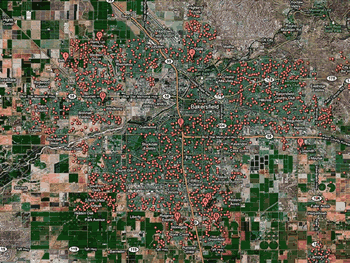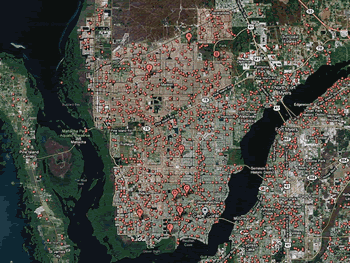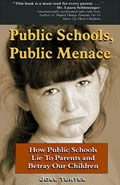PART 1
By
Marilyn M. Barnewall
July 31, 2011
NewsWithViews.com
Watching Congress create a fear-based crisis over the debt ceiling limit this past week has been anything but entertaining. It’s like watching someone with one foot nailed to the floor run in circles, thinking because he/she is moving, it represents progress.
It’s interesting that whenever “they” want to achieve something major… whether it’s the Patriot Act or war in the Middle East or an enemy called “terrorists” that will unify the nation… they use fear as the primary motivator. Fear is one of the strongest. The only thing stronger is faith.
The entire process reminds me of an end-around run. The President, as quarterback, hands the ball off to John Boehner (wide receiver) who passes – but the ball is intercepted by Harry Reid (pass defender) – who changes the direction of the play. When anyone gets close to a touchdown, the President moves the goal posts and the game remains scoreless… but the cheering squads on the sidelines keep chanting the message of one team or the other. Barry and Harry’s team shout “Look out you senior wrecks, come August there will be no checks!” The Boehner team’s cheerleaders tell the people “Listen not to Barack’s demagoguery, your check will come because of our choreography!”
And that’s how political football is played… with your money and mine, of course. It is shameful that the security of the elderly was a playing card in this disgusting deck.
There is a core problem causing our economic woes and everyone ignores it either out of insufficient insight into what is required to get us out of this mess, or because someone thinks it’s a good idea for the American economy to fail. It reminds me a bit of taking your car to a poor mechanic to make it run properly. He can fix the tires, the windshield wipers, change the oil, check the water and cooling fluids, and a myriad of other things – but he doesn’t know a damned thing about the engine. How much help will that mechanic be when your car has serious problems?
Washington is filled with economists and lawyers… they understand our problems from a theoretical perspective. If you move “Piece A,” it will impact “Pieces B and C” this way. They look at the economy like a chess board and understand investment banking in its relationship to the game. They know little or nothing about commercial banking – which is the engine of a capitalist economy. We can thus say the mechanics of our economy tinker, they don’t repair. They are the poor mechanics who got us into the mess – and it requires greater minds than those that caused the problems to solve them.
There are things that can be done to turn the economy around and none of them are even under consideration. For example:
The hardest hit middle class Americans have taken during the past four years is in primary residential real estate. Whether you realize it or not, the lost value of real estate impacts everything else. It is the way our economy is structured – and is largely responsible for credit drying up (which is largely responsible for no business growth – which is largely responsible for no job creation).
The economy is not going to turn around until a firm floor is put under the residential real estate market. It can be done – but elected officials and bureaucrats must understand how commercial banks work. And, they do not.
Most secured loans utilize as collateral a second trust deed on the borrower’s residence. I’m not just talking about mortgage loans; I’m talking about home improvement loans or vacation loans or college (non-federal student) loans, etc. In the early 1990s and while Alan Greenspan was Federal Reserve Chairman, the Fed kept lowering the cost of funds. It encouraged people to re-finance their mortgages. The first time you ever heard of a personal line of credit called a residential credit line was in the early 1990s. People were encouraged to take out a residential credit line, which placed a second trust deed on their primary residence as collateral. In fact, the only way to get this personal line of credit was by putting a lien on the property – usually a second mortgage behind the first lien holder.
Until recently – just before the Lehman Brothers bankruptcy, coincidentally – when you bought a home, you had to put 20 percent down. Lehman was keeping its head above water by using liar loans from mortgage companies it owned – lenders that specialized in making them. It did that so it could create mortgage-backed derivatives. It – along with Goldman Sachs, J.P. Morgan Chase, Morgan Stanley and others – almost bankrupted the world. In fact, the jury is still out on whether they succeeded.
Get ready, because here comes some banker lingo… it can’t be said any other way. When we used to buy a home and made a 20 percent down payment, it resulted in an 80 percent collateral margin on the loan. In other words, the collateral value of the home plus the down payment gave the bank a 100 percent collateral position. Here are some numbers that may help:
Home
purchase price: $200,000
Down payment, 20%: 40,000
Balance/Mortgage: 160,000 -- 80% of home value, 1996
Bank regulations used to require an 80 percent margin be maintained on home loans – whether it is evaluated against a first or second trust deed. Today, that regulation is used selectively.
In 2007, the housing market began its steady decline. By 2010, the above home was re-appraised at $150,000. OMG! You are out of margin! When the FDIC or Comptroller of the Currency auditors come to your bank, your loan will be graded, even though you haven’t missed or been late with a single payment! Regardless of your faithfulness in making payments, the collateral is out of margin. It is an unsafe loan. This is a legitimate claim, by the way.
Chances are, your bank has a large number of such loans because using a borrower’s home has always been the preferred form of loan collateral in the commercial banking industry. Residential real estate has increased in value annually for generations so the risk was minimized… until 2007. Suddenly your bank finds itself on the regulatory watch list because it has too many loans that are out of margin. An otherwise healthy bank is threatened with closure. Some more numbers:
Loan
balance:
$150,000 (after ten years of mortgage payments)
2010 Home value:
150,000 (after the real estate market drop)
There is no margin. To be in margin, an additional $30,000 must be added to the bank’s collateral position.
For the bank to have enough personal collateral from you, $30,000 of good assets must be added to bank’s collateral basket. Most people don’t have that amount sitting around to give the bank as collateral. The bank will soon tell the borrower to bring $30,000 more in assets to put the loan back in margin or the bank will be forced to call the loan and foreclose on your property. The auditors are screaming at the bank because of the margin lapse. They have to do something.
“But I’m not behind in a single payment!” you say, certain the bank won’t foreclose on your home loan just because of some bank regulation. If you’ve been thinking that all of the home foreclosures in process are caused by people who bought a house that was too expensive for them, think again. If you think they’re all people who aren’t making their house payments, think again. If you think the banks aren’t lending money because they don’t have money to lend, thing again. What they don’t have is access to a reliable form of collateral… like your house. Since the residential real estate market is still in a downward spin (and no one in Washington is doing anything intelligent to stop it), what asset does the middle class have available to provide the bank for collateral? Answer: None. No collateral, no loan access.
That explains why your local bank may be in trouble even though most of its loans are not (and thus it is a great takeover target for banksters). This also explains why banks aren’t lending: Without a healthy real estate market, they don’t have a solid collateral base. Too, their personnel’s time is spent dealing with loan margin problems or foreclosures. Only so much can be done in a single day by the same number of people.
Real estate is impacting jobs? Remember, 70 percent of all jobs in America come from independent business… middle class people who own homes and often use them as collateral for business loans are independent business owners.
And now you know why there are no new jobs: There are no homes with reliable dollar value available as loan collateral. Independent business owners can’t hire people. The economy, of course, has some impact on independent business growth because fewer people have money to spend on goods and services. And, there are banks that loaned too much money to contractors who were building new homes and got caught in the housing crunch… and bankers are notoriously bad at handling work-out loans in a way that benefits everyone.
I’m not an economist; just a commercial banker with God-given common sense. My common sense tells me the best way to put a floor under the falling real estate market has nothing to do with the $600 billion the Federal Reserve System plans to inject into the economy this fall. It will do about as much good as the TARP and TALF funds did (read: little to none – it’s the engine that needs help, not the windshield wipers or oil filter – and a limited number of people will have remarkable investment opportunities). If TARP funds had been used to stabilize the housing market rather than bailing out investment bankers who perpetrated fraud on the public, we would be in serious economic recovery by now. Our economy wouldn’t continue to waver between recession and depression.
Ben, rather than throw that $600 billion into greedy hands that do nothing to solve the nation's economic problems, create a real estate stabilization fund. When a bank's mortgage loan (either first or second trust deed) gets out of margin, guarantee that portion of the loan that is out of margin… in the example given above, $30,000. This gets the Comptroller of the Currency (or FDIC) auditors off of the banks' back (which you could do anyway, if you so chose), and it gets the bank off of the backs of consumers who have sacrificed in many ways to repay their mortgage loans and who have a good repayment track record.
This would not apply to new loans… it's not a something for nothing vote-getting kid of deal – which will automatically kill it before it gets started. It's a program designed to put a floor under the housing market to prevent it from falling any further and to stabilize it. It's not a loan. It's a guarantee. Thus, the $600 billion you plan to throw into the greedy hands of the already rich will result in few loan losses. If you really want to save the economy, stabilize the real estate market.
To top that information off, here’s a press release from the Bureau of Economic Analysis, held for release until Friday morning, July 29, 2011:
“Real gross domestic product -- the output of goods and services produced by labor and property located in the United States -- increased at an annual rate of 1.3 percent in the second quarter of 2011, (that is, from the first quarter to the second quarter), according to the "advance" estimate released by the Bureau of Economic Analysis. In the first quarter, real GDP increased 0.4 percent.”
In other words, the President of the United States has lied to us about recovery. He has been telling us that though the economy is slow to recover, it is recovering. How can an economy “recover” when 99.6 percent of the economy did not grow? It cannot!
| Subscribe to the NewsWithViews Daily News Alerts! |
Now, if a little old lady who lives at the base of a big mountain in the countryside can figure that out, why can’t all of those economists in Washington, D.C.?
Below are pictures – each red dot in each picture represents broken hearts, shattered dreams, broken homes, and Americans who have had their false sense of security ripped from their formerly unrealistic view of life. They used to think things like “This is America; we’ll recover.” Or, “Everything is in God’s hands; I just have to trust Him.” They have learned the lesson that taking no action to stop fraud when it occurs is accepting fraud as the standard. They now know that everything is in God’s hands, but we are expected to protect and defend what His hands have so graciously given us.
I apologize for ending an article with such an emotional display of heartbreak as those exhibited below in pictures from Google Mapping.

1. Boise, Idaho -- 1 in 21 homes in foreclosure

2. Sarasota, FL -- 1 in 21 homes in foreclosure

3. Tampa, FL
-- 1 in 20 homes in foreclosure

4. Sacramento,
Calif. -- 1 in 19 homes in foreclosure

5. Bakersfield,
Calif. -- 1 in 17 homes in foreclosure

6. Reno, Nevada
-- 1 in 16 homes in foreclosure (Home of Senator Harry Reid)

7. Miami, FL
-- 1 in 14 homes in foreclosure

8. Phoenix,
AZ -- 1 in 14 homes in foreclosure

9. Cape Coral,
FL -- 1 in 12 homes in foreclosure

10. Las Vegas
-- 1 in 9 homes in foreclosure
Tell them all – the President, the Vice President, the Chairman of the Federal Reserve System, the Secretary of the Treasury, your U.S. Senators and Representatives – tell them all to stop lying to the American people! For part two click below.
Click here for part -----> 1, 2,
� 2011 Marilyn M. Barnewall - All Rights Reserved
Sign Up For Free E-Mail Alerts
Marilyn MacGruder Barnewall began her career in 1956 as a journalist with the Wyoming Eagle in Cheyenne. During her 20 years (plus) as a banker and bank consultant, she wrote extensively for The American Banker, Bank Marketing Magazine, Trust Marketing Magazine, was U.S. Consulting Editor for Private Banker International (London/Dublin), and other major banking industry publications. She has written seven non-fiction books about banking and taught private banking at Colorado University for the American Bankers Association. She has authored seven banking books, one dog book, and two works of fiction (about banking, of course). She has served on numerous Boards in her community.
Barnewall is the former editor of The National Peace Officer Magazine and as a journalist has written guest editorials for the Denver Post, Rocky Mountain News and Newsweek, among others. On the Internet, she has written for News With Views, World Net Daily, Canada Free Press, Christian Business Daily, Business Reform, and others. She has been quoted in Time, Forbes, Wall Street Journal and other national and international publications. She can be found in Who's Who in America, Who's Who of American Women, Who's Who in Finance and Business, and Who's Who in the World.
Web site: http://marilynwrites.blogspot.com
E-Mail: marilynmacg@juno.com










 Share
This Article
Share
This Article





